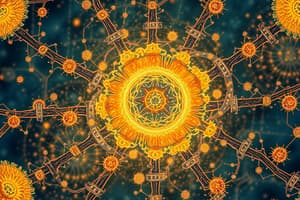Podcast
Questions and Answers
The nuclear lamina is composed of ribosomes.
The nuclear lamina is composed of ribosomes.
False (B)
What is the space between the inner and outer nuclear membranes called?
What is the space between the inner and outer nuclear membranes called?
- Perinuclear space (correct)
- Nucleoplasm
- Nucleolus
- Nuclear lamina
What is the non-membrane-bound structure within the nucleus where ribosome biogenesis occurs?
What is the non-membrane-bound structure within the nucleus where ribosome biogenesis occurs?
nucleolus
The more condensed form of chromatin, found at the periphery of the nucleus, is called ___________.
The more condensed form of chromatin, found at the periphery of the nucleus, is called ___________.
Which of the following best describes the function of euchromatin?
Which of the following best describes the function of euchromatin?
Small molecules require active transport through nuclear pore complexes.
Small molecules require active transport through nuclear pore complexes.
Match the following structures with their function:
Match the following structures with their function:
What type of protein recognizes the nuclear localization signal (NLS) on proteins destined for the nucleus?
What type of protein recognizes the nuclear localization signal (NLS) on proteins destined for the nucleus?
What signal sequences do exportin proteins bind to in order to transport cargo out of the nucleus?
What signal sequences do exportin proteins bind to in order to transport cargo out of the nucleus?
The RanGTPase is not essential for the nuclear export process.
The RanGTPase is not essential for the nuclear export process.
What is the role of RanGAP in the nuclear export process?
What is the role of RanGAP in the nuclear export process?
Proper nuclear transport is crucial for gene expression regulation, cell signaling, and cell ______ control.
Proper nuclear transport is crucial for gene expression regulation, cell signaling, and cell ______ control.
Match the following components with their roles in nuclear export:
Match the following components with their roles in nuclear export:
Flashcards
Exportin
Exportin
A protein that binds to nuclear export signals (NES) on proteins destined for the cytoplasm.
Nuclear Export Signal (NES)
Nuclear Export Signal (NES)
A specific amino acid sequence on a protein that signals its export from the nucleus.
RanGTP
RanGTP
A small GTPase protein involved in the export of proteins and RNAs from the nucleus.
Nuclear Export
Nuclear Export
Signup and view all the flashcards
RanGAP-mediated GTP hydrolysis
RanGAP-mediated GTP hydrolysis
Signup and view all the flashcards
Perinuclear Space
Perinuclear Space
Signup and view all the flashcards
Nuclear Lamina
Nuclear Lamina
Signup and view all the flashcards
Nucleolus
Nucleolus
Signup and view all the flashcards
Euchromatin
Euchromatin
Signup and view all the flashcards
Heterochromatin
Heterochromatin
Signup and view all the flashcards
Nuclear Localization Signal (NLS)
Nuclear Localization Signal (NLS)
Signup and view all the flashcards
Ran
Ran
Signup and view all the flashcards
Study Notes
Nuclear Structure
- The nucleus of eukaryotic cells is enclosed by a double membrane, continuous with the rough endoplasmic reticulum (RER).
- The nuclear envelope displays a cytosolic face with ribosomes and a luminal face, connected to the RER lumen.
- The space between the inner and outer nuclear membranes is the perinuclear space.
- The nuclear envelope is perforated by nuclear pore complexes (NPCs), protein-lined channels.
- The nuclear envelope is reinforced by a network of intermediate filaments, composed of lamins (A, B, and C), forming the nuclear lamina.
- The nuclear lamina provides structural support and shape to the nucleus.
Nuclear Components
- The nucleoplasm, within the nucleus, houses genetic material (DNA) and the nucleolus.
- The nucleolus, a non-membrane-bound structure, is the site of ribosome biogenesis.
- DNA is associated with histones and non-histone proteins, forming chromatin.
- Heterochromatin, a condensed and tightly packed form of chromatin, is peripherally located.
- Euchromatin, a less condensed and dispersed chromatin form, is centrally situated.
Chromatin Structure
- DNA, combined with histones and non-histone proteins, forms chromatin.
- Euchromatin's open structure enables active transcription and gene expression.
- Heterochromatin's compact structure inhibits transcription and maintains inactivity.
Nuclear Transport
- The nuclear envelope's permeability allows small molecules and ions to pass through by passive diffusion.
- Active transport is required for large molecules like proteins and RNA to traverse the nuclear envelope through nuclear pores.
- Specialized proteins, importins and exportins, facilitate this active transport, which needs energy.
Importin-mediated Nuclear Import
- Importin proteins bind to nuclear localization signals (NLS) on proteins destined for the nucleus.
- Importin's alpha subunit recognizes the NLS.
- A complex forms with the cargo protein, importin, and the GTPase Ran, traversing the nuclear pore complex.
- Inside the nucleus, RanGTP causes importin release of the cargo protein.
- Importin-RanGTP complex returns to the cytoplasm, where RanGAP hydrolyzes GTP to GDP, releasing importin.
- The free importin is now ready to bind to another NLS-containing protein.
Exportin-mediated Nuclear Export
- Exportins bind to nuclear export signals (NES) on proteins destined for the cytoplasm.
- An exportin-cargo complex, aided by RanGTP, passes through the NPC.
- RanGTP is crucial as a molecular switch in the export process.
- Outside the nucleus, RanGAP converts RanGTP to RanGDP, releasing the cargo and exportin.
- The exportin-RanGDP complex returns to the nucleus for further transport.
Importance of Nuclear Transport
- Nuclear import and export ensure the proper delivery of proteins and RNAs to their cellular destinations.
- Accurate nuclear transport is vital for gene expression regulation, cell signaling, and controlling the cell cycle.
Key Takeaways
- The nucleus is a crucial and dynamic organelle in cell function, with the organization of chromatin and meticulous molecular transport through the nuclear envelope essential for the nucleus's integrity and for controlling cellular activities.
Studying That Suits You
Use AI to generate personalized quizzes and flashcards to suit your learning preferences.



